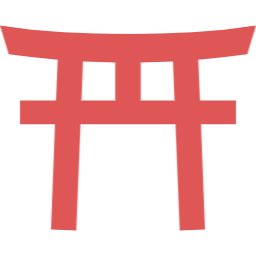【Akama Jingu Shrine summary】
Akama Jingu Shrine was built in 1191. It was built to comfort the souls of Emperor Antoku (8 years old) and the Heike clan who were defeated in the Battle of Dannoura and drowned in the sea. Originally a Buddhist temple called Amida-dera Temple, it became a Shinto shrine under the Shinto/Buddhist Separation Order of the Meiji era. It was renamed Akama Jingu Shrine in 1940.
The deity is Emperor Antoku.
![Akama Jingu Shrine [Yamaguchi] DSC 3781 1024x768 - Akama Jingu Shrine [Yamaguchi]](https://japan-shrine.info/wp-content/uploads/DSC_3781-1024x768.jpg)
【Akama Jingu Shrine Suitenmon】
![Akama Jingu Shrine [Yamaguchi] DSC 3764 1024x768 - Akama Jingu Shrine [Yamaguchi]](https://japan-shrine.info/wp-content/uploads/DSC_3764-1024x768.jpg)
The red shrine gate, modeled after the Dragon’s Palace, is very beautiful and certainly evokes the image of the Dragon’s Palace. This Suitenmon Gate was built in 1957 (Showa 32) to resemble the Dragon’s Palace. It is a rare architectural feature of Japanese shrines, and is well worth seeing. It is now designated as a National Tangible Cultural Property.
![Akama Jingu Shrine [Yamaguchi] DSC 3773 1024x768 - Akama Jingu Shrine [Yamaguchi]](https://japan-shrine.info/wp-content/uploads/DSC_3773-1024x768.jpg)
Looking back after climbing the stairs, you will have a clear view of the Kanmon Straits. The ancient battlefield of Dannoura, where the Heike clan perished, is also nearby.
![Akama Jingu Shrine [Yamaguchi] DSC 3770 1024x768 - Akama Jingu Shrine [Yamaguchi]](https://japan-shrine.info/wp-content/uploads/DSC_3770-1024x768.jpg)
The red shrine gate, which imitates the Dragon’s Palace as Emperor Antoku’s abode under the sea, is very beautiful and certainly makes one imagine the Dragon’s Palace.
【Akama Jingu Shrine Daianden】
![Akama Jingu Shrine [Yamaguchi] DSC 3767 1024x768 - Akama Jingu Shrine [Yamaguchi]](https://japan-shrine.info/wp-content/uploads/DSC_3767-1024x768.jpg)
It was destroyed by fire during the war, but the present magnificent shrine building was erected in 1965.
![Akama Jingu Shrine [Yamaguchi] DSC 3768 1024x768 - Akama Jingu Shrine [Yamaguchi]](https://japan-shrine.info/wp-content/uploads/DSC_3768-1024x768.jpg)
The shrine offers many benefits related to water and the sea, including safe delivery, safe marine transportation, bountiful fish catches, and water business.
【Akama Jingu Shrine Hoichido – Hoichi the Earless】
A statue of Hoichi the Earless is enshrined in the treasure hall next to the hall of worship, along with a picture scroll of the Tale of the Heike. The statue can be viewed for a fee (100 yen), and the “Hoichi Festival” is held on July 15 every year, with a Shinto ritual and biwa (Japanese lute) performance.
![Akama Jingu Shrine [Yamaguchi] 3563100 m 1024x678 - Akama Jingu Shrine [Yamaguchi]](https://japan-shrine.info/wp-content/uploads/3563100_m-1024x678.jpg)
【Akama Jingu Shrine postbox】
![Akama Jingu Shrine [Yamaguchi] DSC 3777 1024x768 - Akama Jingu Shrine [Yamaguchi]](https://japan-shrine.info/wp-content/uploads/DSC_3777-1024x768.jpg)
The post box by the torii gate is light blue and decorated with an objet d’art of fugu (blowfish), a quintessential Shimonoseki sight. Next door is the historically famous fugu restaurant Shunpanro.
【Akama Jingu Shrine Nearby attractions】
Shimonoseki Aquarium, Sumiyoshi Shrine, Kanmon Kaikyo Museum
【Akama Jingu Shrine Access】
Manager’s Comments
I think it is a very beautiful shrine with a magnificent red gate (Suitenmon). There are many other places of interest within the grounds of the shrine, including the tombs of the Heike clan and the Hoichi Hall. If I have a chance, I would like to visit the shrine again. If you are planning to visit the Heike Monogatari, you should not miss this place!
4-1 Amidadera-cho, Shimonoseki-shi, Yamaguchi 750-0003, Japan
※Free parking available
 Tour of Japanese shrines and temples
Tour of Japanese shrines and temples 

![Akama Jingu Shrine [Yamaguchi] 30208887 m 520x300 - Akama Jingu Shrine [Yamaguchi]](https://japan-shrine.info/wp-content/uploads/30208887_m-520x300.jpg)
![Akama Jingu Shrine [Yamaguchi] c67c5adb9d48eae7b08af09fa11a1ce1 - Akama Jingu Shrine [Yamaguchi]](https://japan-shrine.info/wp-content/uploads/sng/c67c5adb9d48eae7b08af09fa11a1ce1.jpg)
![Akama Jingu Shrine [Yamaguchi] 30208887 m 150x150 - Akama Jingu Shrine [Yamaguchi]](https://japan-shrine.info/wp-content/uploads/30208887_m-150x150.jpg)
![Akama Jingu Shrine [Yamaguchi] DSC 3860 150x150 - Akama Jingu Shrine [Yamaguchi]](https://japan-shrine.info/wp-content/uploads/DSC_3860-150x150.jpg)
![Akama Jingu Shrine [Yamaguchi] DSC 1901 150x150 - Akama Jingu Shrine [Yamaguchi]](https://japan-shrine.info/wp-content/uploads/DSC_1901-150x150.jpg)
![Akama Jingu Shrine [Yamaguchi] DSC 3839 150x150 - Akama Jingu Shrine [Yamaguchi]](https://japan-shrine.info/wp-content/uploads/DSC_3839-150x150.jpg)

